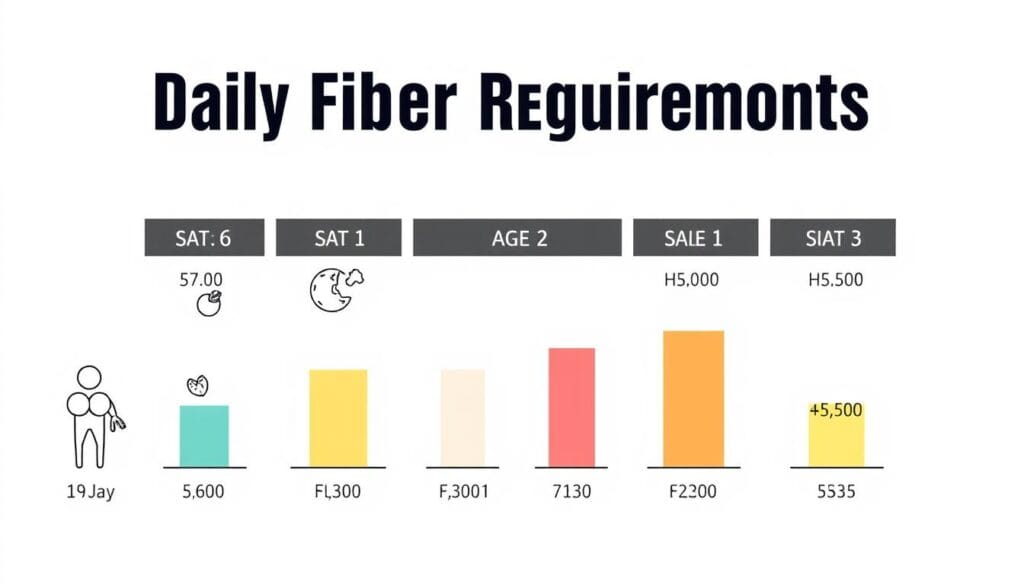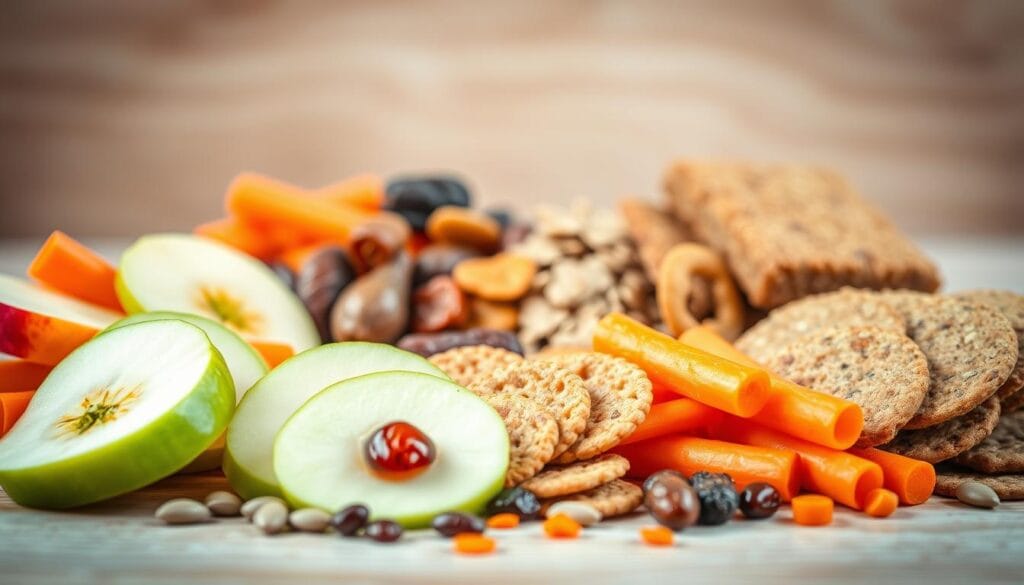Every parent faces the challenge of getting their kids to eat well. As a mom who dealt with picky eating, I found out how important high fiber foods are. Seeing my kids’ energy and health get better made me want to help other parents too.
Fiber is more than just a food tip—it’s key for kids’ growth. It helps with digestion and more. It keeps kids full, gives them steady energy, and supports their body’s functions.
It might seem hard to add high fiber foods to your kids’ diet. But with the right tips and ideas, it can be easy and fun. This guide will show you how to make healthy eating exciting for your kids.
Fiber helps prevent constipation and helps with weight management in kids. By choosing the right foods, you can teach your kids to eat well for life.
Table of Contents
Understanding the Importance of Dietary Fiber for Children
Dietary fiber is key to your child’s health. It helps parents choose better foods for their kids. This supports their growth and development.
Fiber is more than a nutrient. It’s a basic part of good health for kids. Knowing how much fiber kids need helps parents support their wellness.
Benefits for Digestive Health
Your child’s digestive system needs support. Fiber helps by:
- Promoting regular bowel movements
- Preventing constipation
- Supporting a healthy gut microbiome
- Reducing digestive discomfort
“A fiber-rich diet is like a maintenance plan for your child’s digestive system” – Pediatric Nutrition Experts
Role in Child Development
Fiber does more than aid digestion. It’s vital for your child’s growth by:
- Stabilizing blood sugar levels
- Supporting nutrient absorption
- Helping maintain a healthy weight
- Providing sustained energy for learning and playing
Impact on Overall Wellness
More fiber in kids’ diets can lead to better health. A fiber-rich diet may lower risks of:
- Childhood obesity
- Type 2 diabetes
- Heart disease later in life
- Certain digestive disorders
Remember, the right amount of fiber can be a game-changer in your child’s nutritional journey.
Daily Fiber Requirements by Age Group

It’s important to know how much fiber kids need at different ages. The Dietary Guidelines for Americans give us the right amounts. This helps parents make sure their kids eat enough fiber.
Fiber needs change as kids grow up. Young ones and teens have different needs for staying healthy. Here are the fiber amounts they should get each day:
- 1-3 years old: 14 grams of fiber per day
- 4-8 years old: 16-20 grams of fiber per day
- 9-13 years old:
- Girls: 26 grams of fiber
- Boys: 31 grams of fiber
- 14-18 years old:
- Girls: 26 grams of fiber
- Boys: 38 grams of fiber
Keeping track of high fiber foods for kids is key. Most kids in the U.S. don’t get enough fiber. This can hurt their digestion and nutrition.
“Fiber is a critical nutrient that supports digestive health, helps maintain a healthy weight, and provides long-term health benefits,” says pediatric nutritionist Dr. Sarah Miller.
To make sure your child gets enough fiber, add whole grains, fruits, veggies, and legumes to their meals. Start with small changes. This helps them develop good eating habits for life.
Best Sources of High Fiber Foods for Kids
Finding the right high fiber foods for kids can change their diet for the better. Fiber is key for their health, helping with digestion and giving them important nutrients. With the right snacks, their meals can be tasty and healthy.

Parents should aim to add fiber to their kids’ diets with foods they like. It’s all about finding foods that are good for them and fun to eat.
Whole Grains and Cereals
Whole grains are a great start for fiber-rich meals. Here are some top picks:
- Whole wheat bread (3-4 grams of fiber per slice)
- Oatmeal (4 grams of fiber per half-cup)
- Quinoa (5 grams of fiber per cup)
- Brown rice (3.5 grams of fiber per cup)
Fruits and Vegetables
Fruits and veggies are full of fiber and good stuff for kids. Here are some favorites:
- Raspberries (8 grams of fiber per cup)
- Apples with skin (4.4 grams per medium apple)
- Carrots (3.6 grams per cup)
- Sweet potatoes (4 grams per medium potato)
Legumes and Nuts
Legumes and nuts add protein and fiber, keeping kids full and bright:
- Black beans (15 grams of fiber per cup)
- Almonds (3.5 grams per ounce)
- Chickpeas (12.5 grams per cup)
- Edamame (8 grams per cup)
Pro tip: Start with small amounts of these foods and make them fun. This way, your kids will love their healthy meals.
Kid-Friendly Fiber-Rich Breakfast Ideas

Starting the day with high fiber meal ideas for picky eaters can make breakfast fun. Kids might not like healthy foods, but the right recipes can change that. These meals can be tasty and good for them.
Breakfast is a great time to add fiber to your child’s diet. It helps their digestion and gives them energy. The trick is to make these meals fun to look at and taste.
- Oatmeal Parfait: Layer whole grain oats with colorful berries and a drizzle of honey
- Banana Chia Toast: Spread whole wheat bread with almond butter and sliced bananas
- Veggie Scramble: Mix eggs with finely chopped spinach and bell peppers
Fiber is important for kids as they grow. Here’s a quick guide to fiber-rich breakfasts:
| Breakfast Item | Fiber Content | Kid Appeal |
|---|---|---|
| Whole Grain Waffles | 3-4 grams | High (with fruit toppings) |
| Chia Seed Pudding | 5-6 grams | Medium (can be sweet) |
| Fruit and Nut Smoothie | 4-5 grams | High |
Start adding fiber slowly to help kids get used to it. Try different textures, colors, and tastes. This keeps breakfast fun and healthy.
Creative Snacks That Pack a Fiber Punch
Finding tasty ways to add fiber to kids’ diets can be fun. Fiber-rich snacks don’t have to be dull. With creativity, you can make healthy eating fun for kids.

Easy-to-Make Fiber Snacks Kids Will Love
Getting kids to help with snacks makes them more excited about eating fiber. Here are some easy and healthy ideas:
- Fruit and Veggie Pinwheels: Whole wheat tortillas with hummus and colorful veggies
- Homemade Trail Mix: Whole grain cereals, nuts, and dried fruits
- Chia Seed Pudding: A creamy treat with fresh berries
Portable High-Fiber Options for On-the-Go
Busy families need snacks that are easy to take on the go. Here are some quick and nutritious options:
| Snack | Fiber Content | Preparation Time |
|---|---|---|
| Apple Slices with Almond Butter | 4-5 grams | 5 minutes |
| Roasted Chickpea Packets | 6-7 grams | 15 minutes |
| Whole Grain Muffins | 3-4 grams | 30 minutes |
After-School Fiber Boosters
Kids need snacks that give them energy after school. Try colorful and fun ways to present snacks to make them appealing:
- Veggie sticks with bean dip
- Whole grain crackers with cheese
- Smoothies with spinach and berries
Introducing these snacks makes healthy eating an adventure for kids. It supports their growth and development.
Making Fiber Foods Fun and Appealing
Getting kids to eat more fiber can be a fun challenge for parents. Kids often don’t like trying new foods. But, with the right approach, you can make fiber-rich meals exciting.
Make fiber foods look good. Create colorful plates that look like art. Use cookie cutters to make whole-grain sandwiches into fun shapes. Cut fruits and veggies into shapes that make eating fun.
- Turn meal preparation into a game
- Involve kids in choosing and cooking high-fiber ingredients
- Create playful food presentations
There are tasty ways to add fiber to kids’ meals. Blend veggies into smoothies. Mix whole grain cereals with their favorite brands. Or make custom trail mixes with nuts and dried fruits.
“Nutrition can be fun when you make it a family adventure!” – Pediatric Nutritionist
Here are some tips to make fiber foods more appealing:
- Use dips and sauces to enhance flavor
- Experiment with different textures
- Offer choices to create a sense of control
Remember, patience is important. Kids’ tastes change, and consistent, positive exposure helps them eat healthier.
Tips for Increasing Daily Fiber Intake
It can be tough to get kids to eat more fiber. But with the right approach, it can be fun and easy. Start by making small, creative changes to their diet.
Parents are key in introducing healthy foods to kids. With smart strategies, even picky eaters can enjoy high fiber meals.
Gradual Introduction Methods
Begin by adding a little more fiber to your child’s meals. These steps can help:
- Introduce new high-fiber foods one at a time
- Mix small amounts of fiber-rich ingredients into familiar dishes
- Allow children to explore new textures and flavors gradually
Mixing High-Fiber Foods with Favorites
Turn regular meals into fiber-rich treats by adding nutritious foods to favorites:
| Original Food | Fiber-Boosted Version |
|---|---|
| White bread | Whole wheat bread with added seeds |
| Regular pasta | Whole grain pasta with fun shapes |
| Plain cereal | Mixed with high-fiber cereal |
Making Healthy Substitutions
Switching to healthier options can boost your child’s fiber without losing flavor. Try whole grains instead of refined ones and add more fruits and veggies to meals.
“Nutrition is about progress, not perfection. Small changes can lead to big health benefits.” – Pediatric Nutrition Expert
Don’t forget to drink more water with fiber-rich foods. This helps with digestion and keeps kids comfortable. Being patient and consistent is key to teaching kids good eating habits.
Common Challenges and Solutions
Introducing high-fiber foods to kids can be tough for parents. It takes patience, creativity, and smart strategies. Kids often don’t like new foods, because of their looks or feel.
Parents face several challenges:
- Texture sensitivity
- Visual appearance of fiber-rich foods
- Taste preferences
- Unfamiliarity with new food items
Introducing fiber supplements for kids can be done in fun ways. Start by adding small amounts of fiber to foods kids already like. For example, blend veggies into smoothies or use whole grain flour in baked goods.
“Making nutrition fun is the secret to helping kids embrace healthy eating habits.” – Dr. Sarah Reynolds, Pediatric Nutritionist
When usual methods don’t work, try these creative ideas:
- Create colorful food presentations
- Involve children in meal preparation
- Use positive reinforcement
- Offer fiber-rich foods as finger foods
Remember, persistence is key when introducing new foods to children. If you’re facing ongoing challenges, talk to a pediatric nutritionist. They can offer advice that fits your child’s needs.
Conclusion
Creating a balanced diet with high fiber foods for kids is more than just a nutritional strategy—it’s an investment in your child’s long-term health. By understanding the benefits of fiber for child growth, parents can make meaningful dietary choices. These choices support digestive wellness and overall development.
Your journey toward incorporating more fiber-rich foods doesn’t have to be challenging. Start small by introducing whole grains, colorful fruits, and vegetables into meals. These simple changes can transform your child’s eating habits. They provide essential nutrients that support their growing bodies.
Remember that consistency is key when implementing a high-fiber diet. Each meal is an opportunity to nurture your child’s health through smart food selections. The small steps you take today can create lasting positive impacts on your child’s nutrition and well-being.
Ultimately, helping children develop healthy eating habits is about education, patience, and creativity. By making fiber-rich foods appealing and enjoyable, you’ll set the foundation for lifelong nutritional success. This supports your child’s optimal growth and development.

